DC Field
Value
Language
dc.contributor.author
Niggas, Anna
-
dc.contributor.author
Thima Daniel
-
dc.contributor.author
Vukovic, Filip
-
dc.contributor.author
Vojtech, Victoria
-
dc.contributor.author
Werl, Matthias
-
dc.contributor.author
Buck, Jens
-
dc.contributor.author
Eisenmenger-Sittner, Christoph
-
dc.contributor.author
Aumayr, Friedrich
-
dc.contributor.author
Lemell, Christoph
-
dc.contributor.author
Rossnagel, Kai
-
dc.contributor.author
Wilhelm, Richard Arthur
-
dc.date.accessioned
2024-09-10T06:51:25Z
-
dc.date.available
2024-09-10T06:51:25Z
-
dc.date.issued
2024-09-05
-
dc.identifier.citation
<div class="csl-bib-body">
<div class="csl-entry">Niggas, A., Thima Daniel, Vukovic, F., Vojtech, V., Werl, M., Buck, J., Eisenmenger-Sittner, C., Aumayr, F., Lemell, C., Rossnagel, K., & Wilhelm, R. A. (2024). Angle- and Energy-Resolved Spectroscopy of Electrons Emitted from Surfaces by Impact of Slow Highly Charged Ions. In <i>21st Highly Charged Ions Conference: Book of Abstracts</i>. 21st International Highly Charged Ions Conference (HCI-21), Egmond aan Zee, Netherlands (the). http://hdl.handle.net/20.500.12708/200408</div>
</div>
-
dc.identifier.uri
http://hdl.handle.net/20.500.12708/200408
-
dc.description.abstract
Upon impact on a surface, slow highly charged ions (HCIs) deposit large amounts of their potential energy in the very first layers of the material, putting it into an excited state. This can lead to the emission of up to 100 electrons per incident ion within only a few femtoseconds [1]. Total electron yields and properties of electrons from specific Auger-Meitner transitions have been investigated in detail in the last decades. Investigations on the energy and angular distribution of low-energy electrons, however, remain scarce [2,3] although they represent the dominant fraction of all emitted electrons. These low-energy electrons originate either from highly excited states of the projectile stripped off upon impact at the surface or from inelastic electron processes at the surface. As such, the majority of low-energy electrons are not specific to a particular ion-target combination. In this work, we investigate the properties of emission spectra as a function of target thickness from highly- oriented pyrolytic graphite down to bilayer graphene for which inelastic emission processes should be substantially reduced.
To study low-energy electrons in more detail, we employ a new compact electron beam ion source from D.I.S. Germany [4], which can be easily transported between various experimental setups and facilities. During a commissioning beamtime at TU Wien, we could demonstrate the ability of the source to produce HCIs of Ar and Xe with charge states up to Ar15+ and Xe32+, respectively [4]. For high charge states, currents of a few 100 fA can be extracted from the source and focused to a spot of approximately 1 mm diameter at a distance of 500 mm; for low charge states, several tens of pA can be achieved.
The source was then transported and mounted at the versatile ASPHERE III setup at DESY designed for angle-resolved photoelectron spectroscopy (ARPES). The available angle-resolved hemispherical energy analyser was used to study electron emission in ion-surface interactions using both light (He, Ne) and heavy (Xe) ion species for both low (q=1,2) and high (q=20 for Xe) charge states. The results indicate that electrons with higher energies tend to be emitted at higher angles with respect to the surface normal, while low-energy electrons are emitted more isotropically. Additionally, high incident ion charge states result in overall higher electron yields, along with a marked increase in electrons emitted at shallow angles from the target surface. In this contribution, we will present preliminary results of our first angle-resolved ion-induced electron emission spectroscopy (ARIIEES) measurements.
-
dc.language.iso
en
-
dc.subject
2D materials
-
dc.subject
graphene
-
dc.subject
highly charged ions
-
dc.subject
electron emission
-
dc.title
Angle- and Energy-Resolved Spectroscopy of Electrons Emitted from Surfaces by Impact of Slow Highly Charged Ions
en
dc.type
Inproceedings
en
dc.type
Konferenzbeitrag
de
dc.contributor.affiliation
TU Wien, Austria
-
dc.contributor.affiliation
Rupprecht Haensel Laboratory, Hamburg, Germany
-
dc.contributor.affiliation
Kiel University, Germany
-
dc.type.category
Abstract Book Contribution
-
tuw.booktitle
21st Highly Charged Ions Conference: Book of Abstracts
-
tuw.researchTopic.id
M2
-
tuw.researchTopic.id
M1
-
tuw.researchTopic.name
Materials Characterization
-
tuw.researchTopic.name
Surfaces and Interfaces
-
tuw.researchTopic.value
20
-
tuw.researchTopic.value
80
-
tuw.publication.orgunit
E134-03 - Forschungsbereich Atomic and Plasma Physics
-
tuw.publication.orgunit
E136 - Institut für Theoretische Physik
-
tuw.publication.orgunit
E138-03 - Forschungsbereich Functional and Magnetic Materials
-
dc.description.numberOfPages
1
-
tuw.author.orcid
0000-0002-5838-5789
-
tuw.author.orcid
0000-0003-3463-651X
-
tuw.author.orcid
0000-0002-7096-6092
-
tuw.author.orcid
0000-0002-9788-0934
-
tuw.author.orcid
0000-0003-2560-4495
-
tuw.author.orcid
0000-0001-5107-0090
-
tuw.author.orcid
0000-0001-9451-5440
-
tuw.event.name
21st International Highly Charged Ions Conference (HCI-21)
en
tuw.event.startdate
02-09-2024
-
tuw.event.enddate
05-09-2024
-
tuw.event.online
On Site
-
tuw.event.type
Event for scientific audience
-
tuw.event.place
Egmond aan Zee
-
tuw.event.country
NL
-
tuw.event.presenter
Niggas, Anna
-
wb.sciencebranch
Physik, Astronomie
-
wb.sciencebranch.oefos
1030
-
wb.sciencebranch.value
100
-
item.cerifentitytype
Publications
-
item.languageiso639-1
en
-
item.fulltext
no Fulltext
-
item.openairetype
conference paper
-
item.openairecristype
http://purl.org/coar/resource_type/c_5794
-
item.grantfulltext
none
-
crisitem.author.dept
E134-03 - Forschungsbereich Atomic and Plasma Physics
-
crisitem.author.dept
TU Wien
-
crisitem.author.dept
E134-03 - Forschungsbereich Atomic and Plasma Physics
-
crisitem.author.dept
E134-03 - Forschungsbereich Atomic and Plasma Physics
-
crisitem.author.dept
E134-03 - Forschungsbereich Atomic and Plasma Physics
-
crisitem.author.dept
Rupprecht Haensel Laboratory, Hamburg, Germany
-
crisitem.author.dept
E138-03 - Forschungsbereich Functional and Magnetic Materials
-
crisitem.author.dept
E134-03 - Forschungsbereich Atomic and Plasma Physics
-
crisitem.author.dept
E136 - Institut für Theoretische Physik
-
crisitem.author.dept
Deutsches Elektronen-Synchrotron DESY, Germany
-
crisitem.author.dept
E134-03 - Forschungsbereich Atomic and Plasma Physics
-
crisitem.author.orcid
0000-0002-5838-5789
-
crisitem.author.orcid
0000-0003-3463-651X
-
crisitem.author.orcid
0000-0003-2280-6112
-
crisitem.author.orcid
0000-0002-7096-6092
-
crisitem.author.orcid
0000-0002-9788-0934
-
crisitem.author.orcid
0000-0003-2560-4495
-
crisitem.author.orcid
0000-0001-5107-0090
-
crisitem.author.orcid
0000-0001-9451-5440
-
crisitem.author.parentorg
E134 - Institut für Angewandte Physik
-
crisitem.author.parentorg
E134 - Institut für Angewandte Physik
-
crisitem.author.parentorg
E134 - Institut für Angewandte Physik
-
crisitem.author.parentorg
E134 - Institut für Angewandte Physik
-
crisitem.author.parentorg
E138 - Institut für Festkörperphysik
-
crisitem.author.parentorg
E134 - Institut für Angewandte Physik
-
crisitem.author.parentorg
E130 - Fakultät für Physik
-
crisitem.author.parentorg
E134 - Institut für Angewandte Physik
-
Appears in Collections:

